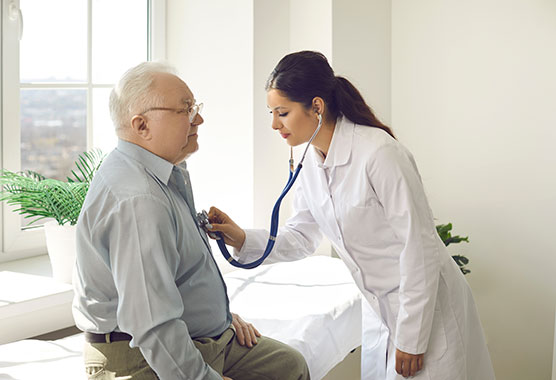Thoracic Aortic Aneurysm
Our vascular team provides the highest level of care to prevent life-threatening complications from aortic aneurysms.
Medically reviewed by Mimmie Kwong, M.D. on June 29, 2023.

What Is a Thoracic Aortic Aneurysm?
A thoracic aortic aneurysm is a weakened spot in the wall of your aorta (the largest artery in your body). As blood flows through your aorta, it pushes against the weak spot and forms a bulge. Thoracic aortic aneurysms are aortic aneurysms that occur in the section of your aorta that runs through your chest.
Without proper and prompt treatment, thoracic aortic aneurysms can lead to life-threatening complications, such as aortic dissection and rupture (complete tear in the aorta).
The UC Davis Vascular Center provides expert care every step of the way for thoracic aortic aneurysms. We strive to detect vascular health conditions early to provide the best possible care and prevent complications. In emergency situations, we offer the most advanced treatments to provide lifesaving interventions.
Thoracic Aortic Aneurysm Symptoms
You may not feel symptoms of a thoracic aortic aneurysm right away. But as the aneurysm grows, symptoms can develop. It is dangerous to dismiss symptoms, so be sure to let your physician know right away if you notice any.
The sooner you get an accurate diagnosis, the sooner you can start treatment to protect yourself from serious complications.
Common Symptoms
Let your physician know if you experience any of these symptoms:
- Back pain
- Hoarse or scratchy voice
- Increased heart rate
- Nausea and vomiting
- Persistent cough
- Shortness of breath during normal activities
Emergency Symptoms
Call 911 immediately if you experience the following symptoms:
- Chest pain
- Clammy skin
- Difficulty breathing or swallowing
- Low blood pressure
- Shortness of breath while resting
Causes of Thoracic Aortic Aneurysm
A thoracic aortic aneurysm can be caused by a medical condition or physical trauma (like an accident) that weakens your aorta, including:
Inherited Health Conditions
Certain inherited (genetic) conditions can cause aortic aneurysms, including:
- Bicuspid aortic valve (BAV)
- Ehlers-Danlos syndrome
- Loeys-Dietz syndrome
- Marfan syndrome
- Turner syndrome
Medical Conditions
Medical conditions that can cause fatty buildup (plaque) or hardening of the walls of your aorta can lead to thoracic aortic aneurysms. These conditions include:
- Atherosclerosis
- Coronary artery disease (CAD)
- Diabetes
- High blood pressure
Infection
Sometimes, an untreated bacterial infection can lead to a thoracic aortic aneurysm.
Inflammation of the Aorta
Conditions that can cause inflammation in your aorta can lead to thoracic aortic aneurysms. These include:
- Giant cell arteritis
- Takayasu arteritis
Injuries
Rarely, traumatic injuries from car accidents or falls that impact your chest can cause a thoracic aortic aneurysm.
Risk Factors for Thoracic Aortic Aneurysm
There are several things that can increase your risk for thoracic aortic aneurysm, including:
Age
People over age 65 are more likely to have a thoracic aortic aneurysm.
Family History
You are more likely to have an aortic aneurysm if other members of your family have had one.
Lifestyle Habits
Certain lifestyle choices can increase your risk of aortic aneurysm, including:
- High amounts of saturated fat, sodium and cholesterol in your diet
- History of smoking or tobacco use
- Sedentary lifestyle with little physical activity
Thoracic Aortic Aneurysm Diagnosis and Testing
Getting an early and accurate diagnosis for a thoracic aortic aneurysm helps prevent life-threatening complications. The UC Davis Vascular Laboratory is accredited in all areas of testing, offering expert diagnostics for all types of vascular conditions.
To diagnose an aortic aneurysm, your specialist will do a physical exam and ask you about your medical history and symptoms. To rule out other conditions and make the most accurate diagnosis, they may recommend imaging tests, including:
Treatments for Thoracic Aortic Aneurysm
UC Davis Health takes a team approach to management with partnership between vascular surgeons, cardiovascular specialists and radiologists.
Treatment options for thoracic aortic aneurysms include:
Medications
Your physician may prescribe medications for health conditions that can cause aneurysms to grow or rupture. These include medications to lower blood pressure (beta blockers) and cholesterol (statins).
Monitoring
If an aneurysm is small, your physician may recommend doing regular follow-up exams with imaging tests. This will help your physician notice any changes in the aneurysm as soon as possible.
Surgery
Your physician may recommend surgery if your aneurysm measures 2 inches or more. Most people with thoracic aortic aneurysms have one of these surgeries:
- Thoracic endovascular aortic repair (TEVAR): Your surgeon inserts a thin, flexible tube (catheter) into your blood vessel through a tiny incision. The catheter has a mesh tube called a graft on one end. Your surgeon guides the catheter to the aneurysm and places the graft inside the bulge. The graft supports the weakened area and helps prevent it from rupturing. This is a minimally invasive procedure.
- Open thoracic aneurysm repair: Your surgeon removes the section of your aorta where the aneurysm is and sews a graft in its place. The surgery is done through a large incision in the center of your chest and has a longer recovery time than TEVAR.
Preventing Thoracic Aortic Aneurysm
A healthy lifestyle can reduce your risk of aortic aneurysm as well as many other vascular conditions. This includes:
- Following a healthy diet
- Getting regular exercise
- Keeping a healthy weight
- Managing medical conditions like diabetes and high blood pressure
- Quitting smoking
How often does it occur?
6-10 in 100KPeople have a thoracic aortic aneurysm
Genetic risk
20%Of all cases are linked to a family history
Source: Society for Vascular Surgery: Thoracic Aortic Aneurysm
Request an Appointment
As Sacramento's No. 1 hospital, you'll benefit from unique advantages in primary care and specialty care. This includes prevention, diagnosis and treatment options from experts in 150 specialties.
Referring Physicians
To refer a patient, submit an electronic referral form or call.
800-4-UCDAVIS
Patients
Call to make an appointment.

